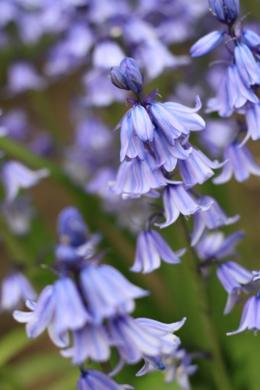The vibrant blues and purples of the bell-shaped bluebell flowers can bring a landscape to life every April and May.

The bluebell flower is a spring-flowering, perennial plant that grows best from bulbs, and belongs to the family of lilies. It is often confused with
Hyacinthus, probably because it's believed to have been evolved from wild species of Hyacinthus, Iris, etc. Whether grown alone or in a mass, it can put up quite a dazzling display, no wonder they are a spring favorite. Not only are they a gardener's favored, spring bulbous flower, their tattoo is popular among tattoo enthusiasts too.
Characteristics
- These flowers grow from bulb and seeds, and in an upright position, until their weight bears the plant down.
- New, narrow, deep, green leaves are usually erect, between 20-40 cms long and 7-15 mm wide that grow on 10-30 cms long stems.
- The spikes begin to develop by March end, are 20-50 cms high, depending upon the cultivar.
- Generally, they grow on only one side of the stem, and are pendulous, tubular with the petals curved outward only at the end, giving it a bell-shaped appearance, hence the name.
- They are arranged in a raceme (a line of flowers growing close to each other), with each raceme bearing between 6 and 20 blossoms.
- Traditionally, they are in hues of blue, purple, or violet, but one can find some very pleasing, cultivated colors too, in shades of white or pink, and sometimes, with cream-colored anthers.
- One of their amazing characteristics is their sweet fragrance, from which their essence is derived.
Procedure of Growing
Growing bluebells is a very pleasurable gardening experience. They can be grown from seeds as well as bulbs, but the ones grown from seeds need plenty of considerations for the blossoms to come true, plus, they take a minimum two years to spring buds. Bulbs on the other hand, will grow next season, beautifully too, and can be stored away for next spring's bloom. Besides the wild or native variety, one can purchase hybrids or a variety of
cultivars bulbs from a reputable vendor. The bulbs you buy can have a sprout or be dried. If its last year's stock you plan to replant, check for any fungus growth, as bulbs not stored properly are susceptible to fungal growth and black mold.
They enjoy partial shade, or diffused lighting if grown indoors. So, select an area that receives adequate light. The bulbs should be planted in late summer or early fall for an early spring or late spring flowering, respectively. Whether in a container or on the ground, dig a hole no deeper than two inches. For the ground, clear all weeds or stones from the inside of the hole, add a little organic mixed soil, and place the bulbs with the flat side (a few sprouted dried roots will be present) down and the pointed end upwards. Gently, spread soil over the bulbs, and water moderately to settle the soil around it. If planning to plant it in a row or a flower bed, then space them 2-3 inch apart. For planting the bulb in a pot, use organic and perlite mixed soil.
Once you see the buds sprout on the spikes, fertilize using an organic compost or liquid fertilizer. Just one application is needed, too much fertilizing will damage the show and turn the leaves yellow. Once the season is over, remove the faded blooms. Cease watering, and leave the stems and foliage to wilt and die down before you remove the bulbs from the ground. It is preferable to leave the bulbs in the ground and space them if they tend to get overcrowded; however, if you need the space to grow winter annuals, then dry and dust the bulbs with fungicide or germicide, before storing them in a dry place. The advantage of leaving the bulbs in the ground is that it will sprout new bulbs and increase the number of plants by next season.
Bluebells are also known as 'wild hyacinth', and have a place in classic Greek mythology. It is believed that they sprang up from the blood of the dying prince
Hyacinthus, and on which
Apollo, his admirer wrote "alas", to express his grief. They do not represent grief to most gardeners who know that in spring they bring joy to the beholder, as the fragrant, bell-shaped flowers surpass many other spring florets in beauty and brightness.






 The bluebell flower is a spring-flowering, perennial plant that grows best from bulbs, and belongs to the family of lilies. It is often confused with Hyacinthus, probably because it's believed to have been evolved from wild species of Hyacinthus, Iris, etc. Whether grown alone or in a mass, it can put up quite a dazzling display, no wonder they are a spring favorite. Not only are they a gardener's favored, spring bulbous flower, their tattoo is popular among tattoo enthusiasts too.
The bluebell flower is a spring-flowering, perennial plant that grows best from bulbs, and belongs to the family of lilies. It is often confused with Hyacinthus, probably because it's believed to have been evolved from wild species of Hyacinthus, Iris, etc. Whether grown alone or in a mass, it can put up quite a dazzling display, no wonder they are a spring favorite. Not only are they a gardener's favored, spring bulbous flower, their tattoo is popular among tattoo enthusiasts too.